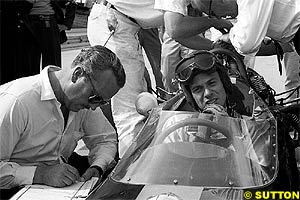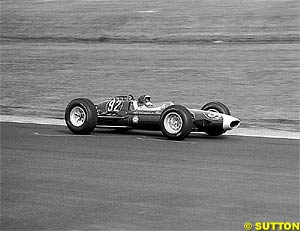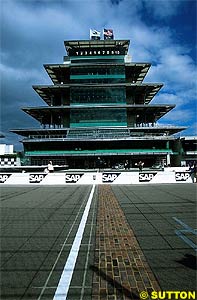
Atlas F1 Contributing Writer
The Indianapolis circuit will welcome Formula One for only the third time this season, but the history of the mythic American circuit dates back to the start of the century. Journalist and historian Doug Nye takes a look back at how "The Brickyard" was born and reviews some memorable moments
It was established on 320 acres of level ground Northwest of the city; a 2½-mile rectangular Speedway with four turns linked by the main straights and straight 'chutes'. The inaugural race meeting was held on August 19, 1909, but the hurriedly completed Motor Speedway's surface of crushed stone and 'asphaltum' broke up, contributing to accidents which killed one driver, two riding mechanics and two unfortunate spectators.
Fisher's management reacted by immediately re-surfacing the Speedway with more than 3-million brick paviours. It took 63 days, the Speedway thereafter was nicknamed 'The Brickyard' and after crowds of over 60,000 paid to attend early events in 1910 the management opted instead for one major race, to be run annually on Memorial Day at the end of May.
Two hundred laps would have to be completed for an unprecedented purse of $25,000.
Two hundred laps meant 500 miles.
The 'Indy 500' had been born.
The '500' was run unbroken from 1911-1916, then from 1919-1941, and from 1946 to the present day, interrupted only by America's late involvement in both World Wars. For 1962 smooth asphalt covered the last remaining bricks, save for a yard-wide section at the finish line.
When Ray Harroun's single-seat Marmon 'Wasp' had won the inaugural 1911 '500' - a result not universally recognised as legitimate - it averaged 74.59mph. Pete de Paolo's even slimmer Duesenberg won the first 100mph '500' in 1925 and the legendary Scottish double-Formula One World Champion Jimmy Clark set the first 150mph race average in his victorious British Racing Green Lotus-Ford 38 in 1965.
Just four gently banked left turns - each identical (but only on the circuit map) - 200 laps - 500 miles - the jewel in the crown of the American National Championship - and the crucible for development of many of the world's most exotic and sophisticated racing cars. That's the Indianapolis Motor Speedway...
Or rather, that was the IMS, for owner Tony George revamped the place specifically to host Formula One in addition to his own IRL brand of oval-track competition through 2000-2001. And this coming weekend the Formula One circus visits the vast facility for the third time.
But forty years ago what might be regarded as the first glimmerings of 'modern era' Formula One were really just waking up to Indy and its glittering prizes. In 1961 Jack Brabham had run his Formula One-based Cooper-Climax there. Sponsored by 'Gentleman Jim' Kimberly, the Kleenex millionaire, this variation upon Jack's 1960 World Championship-winning 'Lowline' Cooper had been stretched in wheelbase and was powered by an oversized 2.75-litre version of the 2½-litre Coventry Climax 4-cylinder Grand Prix engine he'd used for years. The car didn't have the grunt to match the 4.2-litre fuel-injected Indy roadsters with their big 'four-banger' Offenhauser engines on the straights - sorry, straightaways - but 'Blackie' was all over them like a cheap suit through the four long turns.
After a late-race delay when one of his weekend pit crew replaced a knock-off hub cap cross-threaded - then hit it mightily with a hammer - so it had to be hammered back off and the damaged hub thread then filed clean again - Jack finished 9th, but he could easily have been perhaps 4th or 5th and to this day feels he could have done still better than that.
Another Formula One driver who sat up and really took notice of Jack's exploit with the rear-engined, Formula-style car against the Indy establishment was America's Dan Gurney. And forty years ago - in 1962 - it was Dan who really accelerated the intrusion of Formula One-type technology into the heartland of middle America, and into Indianapolis-style motor racing.
"He had some Boeing engineers who were keen to promote these things as high-reliability cheap-to-run engines powering Kenworth trucks. One of the engineers was running one on the street in a '32 Ford roadster, which must have been quite exciting (!).
"But when Jack Zink appeared at Indy with his turbine car he was stiff and sore and his face and arms were covered in scabs and grazes, because while testing the car back at some place in Oklahoma he'd flipped it during a test run. And when I got out on to the Speedway in the car it was plain that its 350 horse-power wasn't enough. A gas turbine develops maximum torque at stall, like a steam engine, so the faster you ran it the less it delivered.
"In those days we were still having to brake into the turns at Indy so when you went back on the gas that turbine could set very competitive corner speeds, and came off the turns with good acceleration. But part way down the straight it would be all over for the day - it just ran out of power and stopped accelerating.
"I was really having to hustle it in the effort to set competitive lap times, and it became clear that it just didn't have enough power. So I told Zink that if he could find anyone who could drive it faster he shouldn't worry about hurting my feelings - he should go right ahead and hire them - and then Mickey Thompson asked if I'd like to drive one of his new rear-engined Buick V8-powered cars.
"They were somewhat like the rear-engined 2.7 Cooper-Climax that Jack Brabham had both pioneered and driven at Indy the previous year, making such an impact. Mickey was the great West Coast hot-rodder and lake car builder who knew all about tuning Detroit V8s, and he'd brought in an English design engineer named John Crosthwaite to build him these Indy Thompson-Buick cars with the engine in the back.
"It was a hell of a car - it really worked well and for qualifying we used Mickey's quarter-mile drag-race engines. They were built for him by Fred Voight, and they just barely survived the four laps - 10 miles - for qualifying. But they were quick - no question. And so I found myself driving in my first oval-track race - the Indianapolis '500'.
"At that time with that kind of technical racing challenge - plus a clear requirement for a dash of salesmanship and, umm, bravado - there was only one guy to approach: Colin Chapman.
"So I approached Colin, I told him that I was running at Indy - we'd both lived through the rear-engined revolution when it came to Formula One and it was plain to me that someone was going to do the same to Indianapolis. That challenge really appealed to Colin, and I thought it would also appeal to Ford.
"When I grew up in racing through the 50s you tended to become either a Ford guy or a Chevrolet guy. I was from the generation that learned about speed with the flat-bead Ford. Until 1955, when they brought out the overhead-valve range. Chevy had always been second-best. We talked about them dismissively as 'Stovebolts'. To us Ford was king.
"So I had this natural affinity with Ford. I'd always enjoyed driving different cars, a different challenge. And I'd just driven a Holman & Moody Ford stock car at Daytona, so I had fresh contact with Ford people. This encouraged me to say to Colin that I would buy him an air ticket to that year's race at Indy to see what it was about, and if he agreed that there was potential for a programme there, then I could introduce him to people at Ford who might be persuaded to fund the thing.
"And that's how it happened. We went to Ford and they recognized it as a great challenge, and appreciated that a Ford win at Indy could be of immense promotional value."
So Formula One and Indy - and a Ford involvement at frontline level - are nothing new to Indianapolis. After their seventh place at Monza was magnified into a third by the inadequacies of Williams-BMW and McLaren-Mercedes, Ford's Jaguar F1 team are hoping to do well upon the parent company's home ground. If they emerge as winners of the rest-versus-Ferrari race once more, there will be many happy faces around the 'Brickyard' - and I suspect that one tall bloke in California will also have that famous dazzling grin beaming from ear to ear at the thought "I started some of that..."
Today, Detroit is famous as America's 'Motown' - motor city, centre of the American motor industry. But back before World War I Indianapolis claimed that role, and there in 1908 local businessman Carl G. Fisher led a consortium to build a major motor speedway. When not hosting sporting events the new motor course was intended to provide a tailor made private industry test track.
 Thereafter this brilliantly promoted race became as much an American sporting tradition as Super Bowl, the World Series or the notion of apple pie. It regularly offered not only a formidable technical challenge, but also motor sport's biggest pay-day worldwide.
Thereafter this brilliantly promoted race became as much an American sporting tradition as Super Bowl, the World Series or the notion of apple pie. It regularly offered not only a formidable technical challenge, but also motor sport's biggest pay-day worldwide.
 Dan was Porsche's number one driver in Formula One that season. And for my late friend - Lotus team manager Andrew Ferguson, and I - he recalled the inception of the Lotus-Ford assault on Indianapolis like this:
Dan was Porsche's number one driver in Formula One that season. And for my late friend - Lotus team manager Andrew Ferguson, and I - he recalled the inception of the Lotus-Ford assault on Indianapolis like this:
"I had first gone to Indy in 1962, at the invitation of an entrant named John Zink. I took the obligatory driver's test in his traditional front-engined Offy roadster, but what he was hoping to qualify for the race was a rear-engined frame - I'm sure it was actually an old Lotus chassis - powered by a Boeing gas turbine!
 "I'd been interested by Indy racing and the disparity between the technology involved and that which I was most used to in European-style road racing. I'd been to Monza in '58 for the Indy car race they ran and had seen the Ecurie Ecosse D-Type Jaguars, with a fraction of the American roadsters' power, still pulling a great tall gear and just about hanging on to them thanks to their better shape. Now I was trying to deduce from that kind of real-life experience how good - or bad - rear-engined road-racing-type chassis might be around an oval compared to the big-time traditional roadsters. I concluded that it was going to happen, and with that thought in mind I went out to see if I could help it happen - to be in there early with good equipment.
"I'd been interested by Indy racing and the disparity between the technology involved and that which I was most used to in European-style road racing. I'd been to Monza in '58 for the Indy car race they ran and had seen the Ecurie Ecosse D-Type Jaguars, with a fraction of the American roadsters' power, still pulling a great tall gear and just about hanging on to them thanks to their better shape. Now I was trying to deduce from that kind of real-life experience how good - or bad - rear-engined road-racing-type chassis might be around an oval compared to the big-time traditional roadsters. I concluded that it was going to happen, and with that thought in mind I went out to see if I could help it happen - to be in there early with good equipment.
 And so a truly modern Formula One approach was applied to the Indy '500'. Jimmy Clark and Dan drove their first Lotus-powered-by-Ford Type 29 cars there in 1963, and Jimmy finished 2nd and darned nearly won. Back again in 1964 the Lotus-Ford works cars - the Type 34s - were let down by their inadequate F1-derived Dunlop tyres. But third time lucky - in 1965 Jimmy won hands down in the fully-developed Indy Lotus-Ford - the Type 38 - and while lady luck never smiled there upon Dan Gurney - the man whose global vision had started all this - he was just as happy as the next man for JC and for Team Lotus, he just wished it had been him.
And so a truly modern Formula One approach was applied to the Indy '500'. Jimmy Clark and Dan drove their first Lotus-powered-by-Ford Type 29 cars there in 1963, and Jimmy finished 2nd and darned nearly won. Back again in 1964 the Lotus-Ford works cars - the Type 34s - were let down by their inadequate F1-derived Dunlop tyres. But third time lucky - in 1965 Jimmy won hands down in the fully-developed Indy Lotus-Ford - the Type 38 - and while lady luck never smiled there upon Dan Gurney - the man whose global vision had started all this - he was just as happy as the next man for JC and for Team Lotus, he just wished it had been him.
Please Contact Us for permission to republish this or any other material from Atlas F1.
|
Volume 8, Issue 39
Atlas F1 Exclusive
Interview with Mark Webber
Articles
50 Years of Ferrari at Indy
Jo Ramirez: a Racing Man
United States GP Preview
The US GP Preview
Local History: US Grand Prix
US Facts, Stats and Memoirs
Columns
The US GP Quiz
Bookworm Critique
The F1 FAQ
Elsewhere in Racing
The Grapevine
> Homepage |